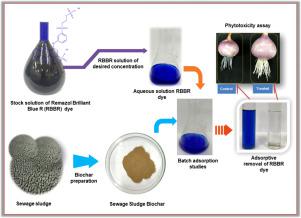Environmental Technology & Innovation ( IF 7.1 ) Pub Date : 2021-04-20 , DOI: 10.1016/j.eti.2021.101556 Abhay Raj , Ashutosh Yadav , Abhay Prakash Rawat , Anil Kumar Singh , Sunil Kumar , Ashutosh Kumar Pandey , Ranjna Sirohi , Ashok Pandey

|
Biochar derived from sewage sludge has emerged as an alternative for sustainable utilization as a soil amendment. However, the use of sewage sludge biochar (SSB) has been less explored in the field of wastewater treatment. Therefore, the purpose of this study was to investigate the efficiency of biochar prepared from sewage sludge at 450 °C (SSB-450), as an adsorbent for the removal of Remazol Brilliant Blue R (RBBR) from an aqueous solution. Brunauer–Emmett–Teller (BET), Scanning Electron Microscopy (SEM) and Fourier Transform Infrared (FTIR) spectroscopy were used to characterize SSB-450, with maximum RBBR removal efficiency. The removal of RBBR from aqueous solution by SSB-450 was investigated in batch mode at varying adsorbent dose, contact time, initial RBBR dye concentration temperature and pH. The BET analysis showed the type IV isotherm that indicates the mesoporous structure of SSB-450. The total pore volume and BET specific surface area of SSB-450 particles were found to be 3.936 cm −3/g and 12.447 m2/g, respectively. The RBBR dye adsorption () at equilibrium by SSB-450 was found to increase from 8.56 to 80.6 mg g−1 with an increase in initial dye concentration from 10 to 100 mg L−1. The maximum monolayer adsorption capacity (qmax) was 126.59 mg/g of SSB-450, determined by the Langmuir adsorption model. At various RBBR dye concentrations (10 to 100 mg/g), the range of the separation factor () was 0.98–0.9, which indicates the favourable adsorption of RBBR dye onto the surface of SSB-450. Besides, Evans blue and triphenyl tetrazolium chloride (TTC) staining of Allium cepa L. roots germinated with dye solutions revealed that biochar treated residual RBBR was non-cytotoxic.
中文翻译:

动力学污泥的动力学和热力学研究从水溶液中去除Remazol亮蓝R染料并评估残留染料的细胞毒性
来自污水污泥的生物碳已作为土壤改良剂成为可持续利用的替代方法。但是,在废水处理领域中很少探索使用污泥生物炭(SSB)。因此,本研究的目的是研究由污水污泥在450°C(SSB-450)制备的生物炭作为吸附剂从水溶液中去除Remazol Brilliant Blue R(RBBR)的效率。使用Brunauer–Emmett–Teller(BET),扫描电子显微镜(SEM)和傅立叶变换红外(FTIR)光谱来表征SSB-450,并具有最大的RBBR去除效率。在不同的吸附剂量,接触时间,初始RBBR染料浓度温度和pH值变化的情况下,以间歇方式研究了SSB-450从水溶液中去除RBBR的过程。BET分析显示IV型等温线,其指示SSB-450的中孔结构。发现SSB-450颗粒的总孔体积和BET比表面积为3.936厘米-3 / g和12.447 m 2 / g。RBBR染料的吸附()通过SSB-450达到平衡时发现)从8.56增加到80.6mg g -1,而初始染料浓度从10增加到100mg L -1。通过Langmuir吸附模型确定的最大单层吸附容量(qmax)为126.59 mg / g SSB-450。在各种RBBR染料浓度(10至100 mg / g)下,分离系数的范围()为0.98-0.9,表明RBBR染料对SSB-450的吸附良好。此外,用染料溶液发芽的葱属洋葱的伊文思蓝和三苯基氯化四唑(TTC)染色显示,经生物炭处理的残留RBBR无细胞毒性。



























 京公网安备 11010802027423号
京公网安备 11010802027423号